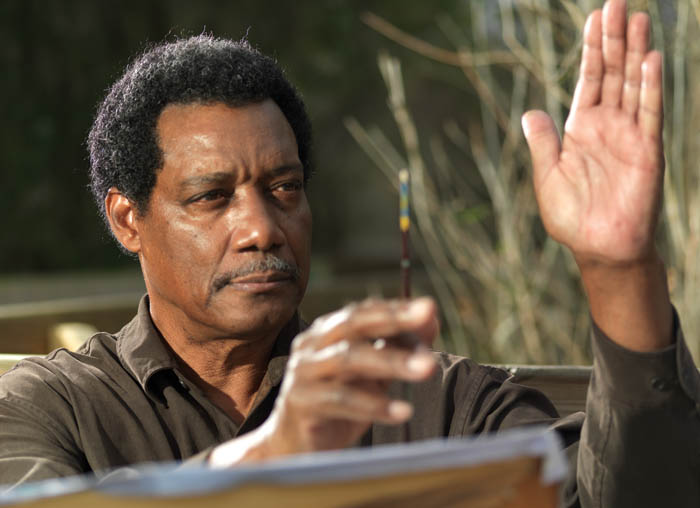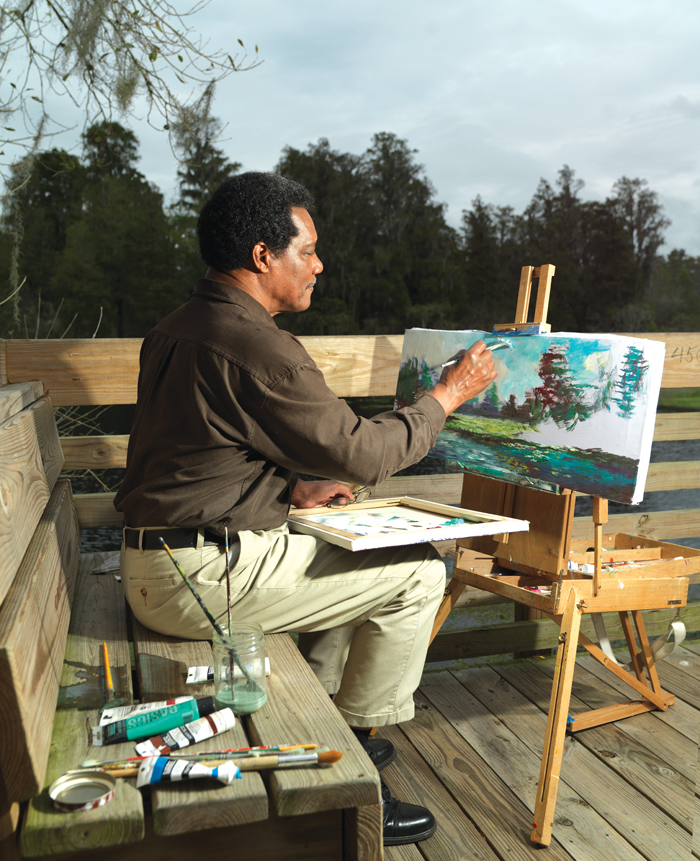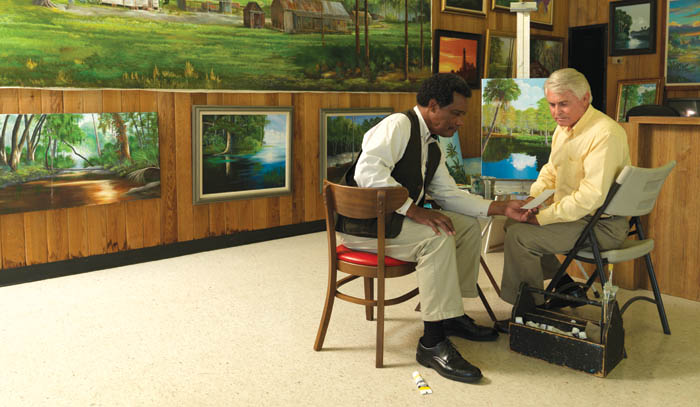
Story by: Erika Vidal Holmes
There’s a path through the Sarasota woods. Butterflies scatter and sunlight drips through the leaves, illuminating the way to a resting place marked by a simple wooden cross that pierces the earth. It’s the grave of a prominent local cattle rancher and conservationist—and the most unusual thing Florida landscape artist Robert Butler has been commissioned to paint.
“The humility of that impression,” he says, “its discreet appearance… I can still see it like I’m standing there.”
Butler has always admired humility. Looking back on the turbulent era in which he came of age, as a black man at the height of the Civil Rights Movement, and living in the deep South, Robert believes that his resistance to judge and be judged is the reason the term “struggling artist” no longer applies to him. That and the fact that he and those who purchase his paintings share a common thread: They are Southerners with a deeply intense connection to the land.
There was a time when Robert couldn’t stand for the sun to set without being in the woods to witness it. When the mere glimpse of a sunset would ignite an urge so strong, he dropped everything in exchange for a paintbrush.The 66-year-old self-taught artist has sold thousands of paintings, and during his early years as a Florida Highwayman—a term coined by art historian Jim Fitch to identify a group of African-American landscape artists who from the mid-1950s through the 1980s traveled Florida selling their paintings out of the backs of their cars—he estimates he painted 150 pieces a year. He has more private and corporate collectors than he can count, with many of his originals now selling for upwards of $25,000. His work has graced the walls of countless Bay-area establishments and museums worldwide, and by 1993 he had documented nearly every ecosystem in the state. From Florida’s cracker cowboy culture to its fruitful agricultural history, Robert has left few stones unturned in his mission to preserve the corner of the country he says is glued to his heart.
He is known for his meticulous attention to detail, historical accuracy and what his friend and agent, Carl Norton, calls a “Robert Butler sky.” Butler likes to think of himself as a “historian with a paintbrush.” He hopes that will be his legacy.
“People who are moving (to Florida) don’t have a hint of an idea of the history associated with it. Something was satisfied in here,” he says, drumming his chest, of documenting places drowned out by development. “These people are not going to look back and see beautiful Florida, covered with concrete and asphalt.”

HUMBLE BEGINNINGSRobert Butler couldn’t know it at the time, but Okeechobee was just what he needed. He and his mother, Annie, moved there in 1947 from Baxley, Ga., after his parents separated. Robert was 4.
“Of all the places in the world,” he says, shaking his head.
Ranches, cattle, wild turkey, hogs, lakes, marshlands. The cow pasture down the road was his “Shangri-la,” a dream world of puffy white clouds and the breeze, bending blades of grass, of crisp blue skies filled with egrets. To this day when he paints, the image of countless birds soaring above that stretch of land is part of him. He grew up a hunter and fisherman; two pastimes he believes played a fundamental role in his understanding of nature.
“I had an insatiable curiosity about the world around me. I gotta know what’s over there,” he says, pointing his finger repeatedly. “That need to paint nature was engrained in me very early.”
Butler sold his first commissioned painting to his seventh-grade teacher. It was a moonlit scene of a boat on a lake. He peddled his paintings at bars, doctor’s offices, nearby ranches and anywhere else he thought he might be able to make a buck.
“In the old days, I painted every day. Whatever was in my mind, I painted,” he says. “Since I never had any training, that has been a great key to my success because I had no boundaries. Nobody told me I couldn’t mix two colors, so I had a totally clean world to operate in and that huge curiosity I had just led me in all directions.”
In the 1960s that curiosity, coupled with his need to make a living, led Butler to take his first love on the road. He’d load up his Oldsmobile Catalina with as many paintings as he could and drive for miles, days—as long as it took to sell every last piece.
By 1968, after quitting his job as a hospital orderly to make a career of painting, Butler was on the road full-time. He was married, and the first four of nine children were born. His reputation among the state’s most prominent cattle ranchers, Ben Hill Griffin and Charlie Mack Overstreet among them, was growing through word of mouth. At one point, he knew and painted for just about every rancher in the state. He once accompanied hunting enthusiast Maj. Gen. O.L. Peacock and a group of his friends on a hunting safari in Africa. Butler went as “artist to the expedition,” documenting the journey on canvas and giving the paintings to Peacock as a gift. It was an experience that changed both his way of thinking and painting.
Throughout his career, Butler has been involved with more than 50 local fundraising and conservation groups and has helped raise more than a half-million dollars for charity. He believes his involvement in these philanthropic efforts is another reason for his success. Often while working these events, he invites local celebrities to paint with him. He has shared a canvas with Lee Roy Selmon and Governors Jeb Bush and Charlie Crist, making those particular pieces that much more valuable.
Butler also teaches art, which he discovered he loves almost as much as painting. One of his students, Levy Harrison, owner of a tire repair shop in Lakeland, says that if it weren’t for Butler he may never have picked up a brush.
“He came in one day (in April 1986) to get a tire repaired and we started talking,” Harrison says. “I had never met him before, but I really admired the artwork he was doing. I saw it in people’s offices around town. I told him, ‘I wish I could do something like that.’ He said, ‘Well, maybe you can.’”
Levy’s wife signed him up, and the first lesson flew by.
“We went in (to Butler’s art gallery) at around 6pm, started painting, and before I knew it, it was midnight and I did not know where the night had gone. It felt like we had only been painting for half an hour. I did not know anything other than what I was doing. I carried home a finished painting. I’ve been painting ever since.”
That was more than 20 years ago. Harrison now teaches art classes two nights a week at his shop, Levy’s Imperial Tire in Lakeland. He and Butler trade each other their originals, and several Butler paintings are on display at the shop.
For Butler, passing on his passion is another way to make the most of the talent he was given.
“When I started, I didn’t know how far I was going to go,” Butler says. “I just knew that I owed it to that ability to give it everything I’ve got. That’s what I’ve been taught about gifts like that.”
THE NEXT CHAPTER

In the second-floor office of his Lakeland home, Butler is hard at work on the story of his life. After his stroke in 2003, he thought he was finished painting, so that’s when he began writing. He hasn’t found a publisher yet, but hopes to have one by Black History Month in February, when his exhibit premieres at the LeMoyne Center for the Visual Arts in Tallahassee, a venue he calls “the cream of the crop” for an artist of his nature.
He fiddles with his Sony desktop. The names and phone numbers he uses most often are scribbled onto his monitor in black marker.
A bold abstract painting leans against the only easel in the room. It looks like a meadow on fire. He made this particular piece for the book, and he’ll likely show it at LeMoyne.
Butler’s not sure what’s next. Maybe he’ll go on sabbatical. Maybe he’ll head out West and tackle that landscape.
“I knew always that I had to have somewhere else to go,” Butler says. “The world is an awful big place.”
The HighwaymenIn the early 1950s and through the 1980s a group of 26 African-American self-taught artists painted works depicting the largely undeveloped Florida landscape of their time. They painted from their garages and back yards (Robert Butler often painted at motels), mostly on inexpensive Upson board. On the weekends, they traveled and sold their paintings to hotels, offices, businesses and individuals for around $25 a piece.
The once-obscure group was brought to the mainstream’s attention in the mid-1990s by Florida art historian and collector Jim Fitch, who coined the term “Highwaymen” because the artists’ “marketing and sales strategy consisted of traveling the highways and byways of central Florida peddling their paintings out of the back of their cars.”
In 2004 the 26 original Florida Highwaymen were inducted into the Florida Artists Hall of Fame.THE 26 FLORIDA HIGHWAYMEN ARTISTS ARE: